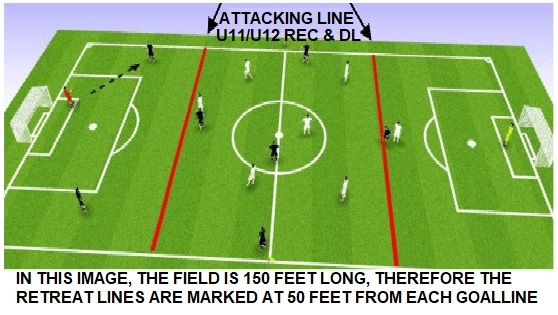U11/U12 Attacking Line Rule
U11 and U12 Attacking Line Rule
In these matches, offside is enforced only within the attacking third of the playing area on each side of the pitch.

Officials are reminded that there is no “offside line” (unlike a blueline in hockey). The offside rule is applied in the same manner as standard 11 v 11 outdoor soccer, with the modification that it is only enforced within the attacking third of the field of play.
Because the key moment of judgment is when the ball is played, a player may receive the ball within the attacking third but not necessarily be offside if, at the moment the ball was played, they were positioned outside the attacking third.
To consider whether a player may be offside, the player must satisfy both of the following at the moment the ball is played:
- Being within the attacking third of the pitch
- Being in an offside position
Once these two conditions are met, the referee can then determine whether the player is:
- Interfering with play
- Interfering with an opponent
- Gaining an advantage by being in that position
To assist referees and to help explain the application of offside in these matches, the following diagrams illustrate common scenarios:
1. Offside Scenario #1 — Attacker in an offside position within the attacking third
Decision: Offside — The attacker (red) is in an offside position because they are closer to the goal line than the second last defender. When the ball is played to them, offside is enforced because the player was in an offside position within the attacking third and interfered with play.
2. Offside Scenario #2 — Player making the pass and receiver both within the attacking third and behind the second last defender
Decision: Offside — Both attacking players (red) are behind the second last defender and within the attacking third. When the pass is made, the receiving attacker is in an offside position, within the attacking third, ahead of the ball, and interferes with play. Offside is called.
3. No Offside Scenario #1 — Pass made within the attacking third, both behind defender, but receiver is behind the ball
Decision: No Offside — Although both attackers are behind the second last defender and within the attacking third, the receiving attacker is behind the ball when it is played. As the player does not meet the requirement of being in an offside position, the referee cannot call offside.
4. No Offside Scenario #2 — Both attackers behind the second last defender but outside the attacking third
Decision: No Offside — Both attackers are behind the second last defender, but the play occurs outside the attacking third. Since offside can only be considered within the attacking third, the referee cannot penalize offside.
